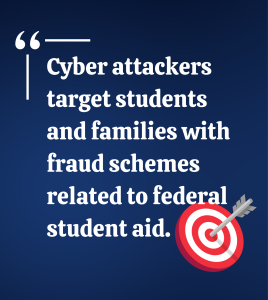Student Loan Fraud: Don’t get a Fraudulent Education

The back-to-college season brings excitement and new challenges for new students. While they embrace new places and faces, they also face financial pressures. Unfortunately, cyber attackers capitalize on this, targeting students and families with fraud schemes related to federal student aid. These malicious activities, including scams and phishing attempts, aim to steal personal and financial data through fake websites, emails, and calls. The ultimate goal is to deceive individuals into disclosing sensitive information like Social Security numbers, bank details, or Federal Student Aid IDs.

Common Warning Signs and Red Flags
1. Unsolicited Communication:
- Emails or phone calls claiming to be from the U.S. Department of Education or your financial aid office that you didn’t expect.
- Messages that pressure you to act quickly or face losing your financial aid.
2. Requests for Personal Information:
- Legitimate organizations will never ask for sensitive information like your Social Security number, FSA ID, or bank account details through email or phone.
- Be cautious of email links directing you to websites where you’re asked to enter personal information.
3. Suspicious Email Addresses and URLs:
- Phishing emails often come from addresses similar to official ones but contain slight misspellings or odd characters.
- Verify URLs by hovering over the link to see if it directs to a legitimate website (e.g., .gov websites for federal aid).
4. Grammar and Spelling Errors:
- Scammers often make mistakes in their communications. Watch for poor grammar, spelling mistakes, and awkward phrasing in emails and messages.
5. Too Good to Be True Offers:
- Be wary of promises such as guaranteed approval for aid, scholarships you didn’t apply for, or unusually high amounts of aid.
How to Avoid Federal Student Aid Fraud Scams and Phishing Attacks:
- Always verify the legitimacy of the email or phone call by contacting the organization directly using the contact information from their official website.
- Do not click on links or open attachments in unsolicited emails. Instead, go directly to the organization’s official website by typing the URL into your browser.
- Never share your personal information via email or phone unless you initiated the contact and know the recipient’s identity.
- Use strong, unique passwords for your financial aid accounts and enable multi-factor authentication (MFA) when available.
- Stay informed about the latest scams
A final tip:
The Federal Student Aid Office of the U.S. Department of Education restricts all communication to these three email accounts:
- Noreply[@]studentaid.gov
- noreply[@]debtrelief.studentaid.gov
- ed.gov[@]public.govdelivery.com
Any communication from an email address other than one of these may be fraudulent.
Stay vigilant and informed to protect yourself from federal student aid fraud scams and phishing attacks. If something seems suspicious, trust your instincts and verify before acting. Your financial future and personal information are too important to risk.
Share:
Disclosures
The material on this site was created for educational purposes. It is not intended to be and should not be treated as legal, tax, investment, accounting, or other professional advice.
Securities and Insurance Products:
NOT A DEPOSIT | NOT FDIC INSURED | NOT BANK GUARANTEED | NOT INSURED BY ANY FEDERAL GOVERNMENT AGENCY | MAY LOSE VALUE
